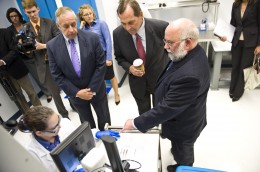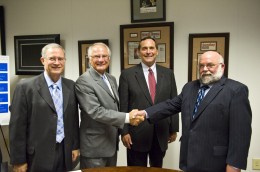
Mound Laser and Photonics Center President and CEO Larry Dosser let guests see first hand what his company's lasers can do after the news conference Monday, July 18.
The work is precise and delicate. Lasers are used to fashion miniature devices for the defense and medical device industries. The devices are so small that they can be inserted into the heart, brain and ear or applied to the construction of a micro air vehicle.
The demand for these important products crafted by the Mound Laser & Photonics Center, Inc. (MLPC) is so strong that the Dayton-area company–which has watched its workforce mushroom from four employees to 42–will have record sales this year.
To amplify the company’s growing impact on the economy, Wright State University announced July 18 that it is taking the unusual step of embedding a faculty member in the company as part of a novel business agreement.
The idea is to speed the commercialization of research and overcome traditional roadblocks that often keep businesses and universities from working closely together.

Jack Bantle, VP Research and Graduate Studies; President David R. Hopkins, Wright State University; Chancellor Jim Petro, Ohio Board of Regents and Larry Dosser, President and CEO of the Mound Laser and Photonics Center pose for a picture after signing the agreement.
“This extraordinary partnership will marry the missions of academia and business,” said Wright State President David R. Hopkins. “The university will supply research expertise while learning the needs and challenges of business. It’s a way for Wright State to directly participate in economic development.”
Jim Petro, chancellor of the Ohio Board of Regents, attended the signing ceremony at MLPC’s headquarters in Miamisburg to congratulate the university and business on this best practice arrangement and encourage that it be modeled and replicated across the state.
“This creative arrangement will likely propel more university research into the marketplace, creating jobs and spinoff businesses,” Petro said. “Universities around the state should look at this as a model for quickly translating ideas into products and services that will help grow Ohio’s economy.”
Normally, a partnership between a university and business is limited to student internships, the licensing of intellectual property or industry-sponsored research and development projects. Most of these approaches tend to be short term and tied to a specific project, and processes for launching new projects can be cumbersome because of the lack of permanent ties.
Under the new business model, Wright State and MLPC will share a faculty member, with each paying 50 percent of his or her salary and benefits. The faculty member will have a lab at MLPC, and company personnel will have access to equipment at Wright State. Graduate students would also work at MLPC.
This concept was advanced by associate vice president for research and dean of the graduate school, Andrew Hsu, Ph.D. The faculty member will be a part of the Mechanical and Materials Engineering Department chaired by George Huang, Ph.D., and in the College of Engineering and Computer Science led by S. Narayanan, Ph.D.
Jack Bantle, Ph.D., vice president of research and graduate studies at Wright State, said universities foster a free and open exchange of ideas, while businesses typically operate with a degree of secrecy to prevent their ideas and inventions from being hijacked by competitors.
“We think we’ve found a formula that’s going to keep research in play,” Bantle said. “A permanent relationship with a company enables us to minimize or eliminate the clashing of the two cultures and get immediate feedback. This model will remove roadblocks and help the university and MLPC more quickly commercialize ideas.”
Such an arrangement is highly unusual, but not unique. For example, the University of Technology in Dresden, Germany, has a similar arrangement with Fraunhofer IWS, a company that specializes in laser technology.
Larry Dosser, president and CEO of MLPC, proposed the business model with Wright State back in January.
“We enjoy working relationships with universities around the area, but we need to have something more in-depth than that,” he said. “If we’re going to grow the research-and-development capability in this company, we need to increase our technical depth at the doctoral level. The university is the ideal resource.”
MLPC has about $5 million in equipment, including 18 laser systems. The lasers are used in microfabrication–the cutting, drilling, welding and machining of very tiny devices used in everything from heart procedures to micro air vehicles.
“We do things here that no other company is able to do,” said Dosser, who has a doctorate in physical chemistry and worked at the former Mound nuclear weapons plant for 15 years. “Some of the things we do are pushing technology to the limit.”
Under the business agreement, Dosser can share his company’s lasers with Wright State while getting access to university equipment such as scanning electron microscopes, which he can’t afford to buy.
“We’re going to be an extension of the university, and the university is going to be an extension of us,” Dosser said. “We were able to accomplish this because there is a strong element of trust between us.”
Having Wright State researchers as part of MLPC will enable the company to react quickly to contract and grant proposals, gaining an edge over businesses that must first build a team, Dosser said. And winning those dollars is a win for the region.
“The program is designed to accelerate the commercialization of technology, which translates to hiring more people at all stages of the company: R&D, prototyping, process development and production, all with a focus on quality and time to market.” he said. “All this means enhanced growth and jobs for our young people. Simply put, this model is another step towards building the advanced manufacturing workforce of the future.”
Both the university and MLPC will publish and patent joint intellectual property that comes out of the relationship while still protecting trade secret information.
The Wright State professor to be embedded will be jointly selected by the university and MLPC. The selection process will begin in August.

 Bags, boards and bonding
Bags, boards and bonding  More than 1,000 students to graduate at Wright State’s fall commencement ceremonies
More than 1,000 students to graduate at Wright State’s fall commencement ceremonies  Wright State’s Take Flight Program helps students soar high
Wright State’s Take Flight Program helps students soar high  Wright State Police Department delivers major donation to Raider Food Pantry
Wright State Police Department delivers major donation to Raider Food Pantry  Wright State engineering and computer science students earn prestigious federal SMART Scholarships
Wright State engineering and computer science students earn prestigious federal SMART Scholarships 